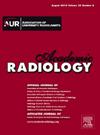Comparison of Peer Reviewer Instructions of Radiology Journals to Recommended Peer Review Checklists
IF 3.8
2区 医学
Q1 RADIOLOGY, NUCLEAR MEDICINE & MEDICAL IMAGING
引用次数: 0
Abstract
Rationale and Objectives
The objective of this study was to identify differences in peer review guidance provided to reviewer by journals, and to compare radiology journal instructions to recommended peer review checklists.
Methods
Peer review instructions from four prominent radiology journals (Radiology, JACR, Academic Radiology, AJR) were obtained from journal websites and instructions to reviewers in the journal. Two recommended checklists from radiology literature published by Provenzale and Stanley in 2005 with 30 items, and another by Duchesne and Jannin with 69 items published in 2008 were utilized. Journal-based instructions were compared to both recommended checklists using Excel.
Results
Variability was observed in the online available instructions for reviewers of the four radiology journals. Radiology journals’ instructions for reviewers were more likely to address certain parts of the manuscript. Items that were consistently emphasized included rationale, reproducibility, results of statistical test, whether results justify the conclusion, whether the research question was addressed, and the clinical and practical applicability. Other items that were more likely to be mentioned in the instruction checklists include; if the abstract stands alone, a sufficient and concise background, logical flow of results that follows from the methods, appropriate tables and figures, and appropriate references. Items least likely to be addressed included the title, keywords, justification of study design and study methodology, unexpected results, generalizability of findings, and ethical considerations.
Conclusion
Variability was observed in journals’ guidelines for reviewers. This could be attributed to differences in journal aims, scopes, and article types. Radiology journals’ instructions for reviewers are more likely to address certain parts of the manuscript.
放射学期刊同行评议指南与推荐同行评议清单的比较。
基本原理和目的:本研究的目的是确定期刊提供给审稿人的同行评议指南的差异,并将放射学期刊指南与推荐的同行评议清单进行比较。方法:从《radiology》、《JACR》、《Academic radiology》、《AJR》四家著名放射学期刊的同行评议说明及期刊审稿人说明中获取。采用2005年Provenzale和Stanley发表的两份推荐的放射学文献检查表(30项)和2008年Duchesne和Jannin发表的另一份推荐的检查表(69项)。将基于日志的指示与使用Excel的两种推荐清单进行比较。结果:在四种放射学期刊的在线审稿人指南中观察到可变性。放射学期刊对审稿人的指示更有可能针对手稿的某些部分。一直强调的项目包括基本原理、可重复性、统计检验结果、结果是否证明结论、研究问题是否得到解决、临床和实际适用性。其他更有可能在指令清单中提到的项目包括;如果摘要是独立的,那么要有充分而简洁的背景,从方法中得出的结果的逻辑流程,适当的表格和图表,以及适当的参考文献。最不可能涉及的项目包括标题、关键词、研究设计和研究方法的理由、意外结果、研究结果的普遍性和伦理考虑。结论:期刊审稿人指南存在差异。这可能归因于期刊目标、范围和文章类型的差异。放射学期刊对审稿人的指示更有可能针对手稿的某些部分。
本文章由计算机程序翻译,如有差异,请以英文原文为准。
求助全文
约1分钟内获得全文
求助全文
来源期刊

Academic Radiology
医学-核医学
CiteScore
7.60
自引率
10.40%
发文量
432
审稿时长
18 days
期刊介绍:
Academic Radiology publishes original reports of clinical and laboratory investigations in diagnostic imaging, the diagnostic use of radioactive isotopes, computed tomography, positron emission tomography, magnetic resonance imaging, ultrasound, digital subtraction angiography, image-guided interventions and related techniques. It also includes brief technical reports describing original observations, techniques, and instrumental developments; state-of-the-art reports on clinical issues, new technology and other topics of current medical importance; meta-analyses; scientific studies and opinions on radiologic education; and letters to the Editor.
 求助内容:
求助内容: 应助结果提醒方式:
应助结果提醒方式:


